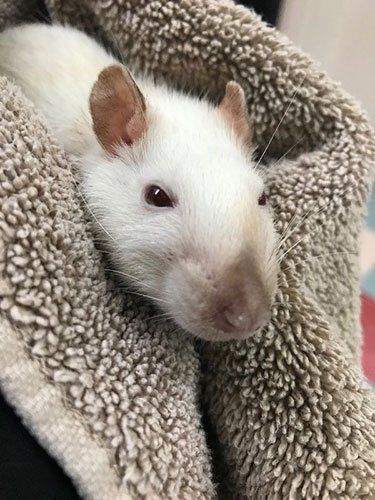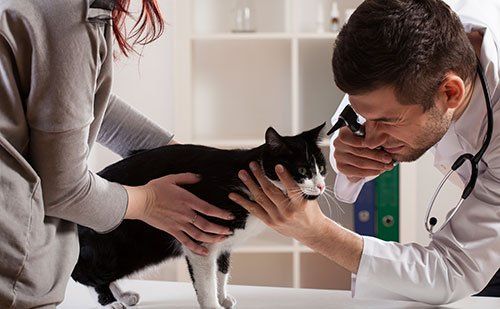OSTEOARTHRITIS IN DOGS
Admin • December 14, 2017
Inflammation within the joints, osteoarthritis
, is common in dogs with about 20% suffering the effects. It is a slowly evolving disease with development of joint pain, stiffness and limitation of motion. The most common cause is abnormal stresses on normal cartilage. Even tiny imperfections in the joints can lead to mechanical breakdowns and the resultant inflammation. The progression of the disease can be affected by body weight, amount of exercise and genetic influences.
The first symptom is loss of normal performance followed by stiffness after rest that usually lasts only a few minutes. Next, quality of life is affected – decreased exercise tolerance, not getting in or out of the car without help and decreased activity. These problems are frequently blamed on the pet’s increasing age. Progressive disease leads to lameness of a sudden or slow development. In some dogs there may be behavioral effects of joint discomfort including nervousness, aggression, depression and loss of appetite.

There is no cure for osteoarthrosis but rather the progressive condition is “managed.” In dogs the therapy goals are influenced by the severity of the symptoms, the intended activity, age and size and any concurrent disease or drug therapy that may interfere with the use of anti-inflammatory drugs.
The most important treatment in overweight pets is weight loss. Obese dogs can become free of symptoms once they have achieved ideal body weight or be managed with lower dosages of pain relieving and anti-inflammatory medications.
Medical therapy will vary depending on the severity and location of the osteoarthritis. With medical therapy it is most effective as multi-modal treatment (2 or more different types) and best started prior to development of chronic pain. Once chronic pain is established medical therapy is generally not as effective. Similarly pharmaceuticals should be given regularly and not “as needed” after the pain worsens.
In most patients unless the osteoarthritis is mild the use of a non-steroid anti-inflammatory drug (NSAID) is indicated. These drugs while not addressing the underlying cause do control pain and inflammation allowing improved mobility. The most commonly used are referred to as COX enzyme inhibitors. COX enzymes are used by the body to produce prostaglandins. The “bad” prostaglandins cause inflammation and the “good” prostaglandins protect the stomach. This is in part why some patients can have stomach upset with the COX enzyme inhibiting non-steroidal anti-inflammatory drugs. A newer drug called grapiprant (Galliprant®) does not inhibit the COX enzymes but works by blocking the inflammation and pain producing prostaglandin receptor. For those who have digestive issues with other non-steroidal anti-inflammatory drugs they generally do well with grapiprant.
A pain relieving drug, Gabapentin, is generally very effective combined with an NSAID or sometimes used alone in mild cases. It is particularly helpful in dealing with chronic or neuropathic pain. It is generally started at a low dose and the dosage gradually increased to avoid the common side effect of sedation. It may not be helpful in patients until a high dosage is reached. The medication is safe for long-term use.
Opiates particularly Tramadol can provide pain relief and are generally well tolerated. There appears to be individual variation in responsiveness to these medications and with chronic pain full effect may not be seen until after 2 weeks. Due to potential changes in alertness and behavior, Tramadol may not be good for working or service dogs, and check with your veterinarian before using with anti-anxiety medications.
Adequan® is an injectable glycosaminoglcin which is a major component of joint cartilage. The specific mechanism of action in dog joints is unknown. It is perhaps best used when the osteoarthrosis is at an early stage and when used alone at this time many clients report significant improvement in mobility.
In regards to glucosamine, chondroitin sulfate and green lipped mussel, there are no studies to document effectiveness other than those conducted by the manufacturers. Unlike an injection of Adequan®, since these products are given orally they may be degraded to other compounds by the stomach and digestive enzymes prior to absorption. Since these products are not regulated as pharmaceuticals the actual quality of these products varies widely. Cosequin® manufactured by Nutramax Labs is a reputable product.
For those patients that are not responsive to previously reviewed medications the injection into the joint(s) of hyaluronic acid or corticosteroids or the use of PRP (platelet rich plasma) is indicated. Hyaluronic acid is a form of viscosupplementation which restores the physical properties of the joint fluid to aid in the lubrication of the joint, decrease inflammation and degradation, and help in cartilage repair. Used alone it is useful for mild to moderate osteoarthritis but in severe cases it is used with corticosteroids or PRP. Corticosteroid injections into the affected joint(s) reduce inflammation and improve comfort with 2 injections separated by 3 weeks lasting weeks to months. PRP reportedly has an anti-inflammatory and analgesic effect; has cartilage protective effects and improves the viscoelastic properties of joint fluid. For most patients joint injections require sedation.
For most dogs symptoms associated with osteoarthrosis can be relieved with weight loss if needed, exercise in moderation and pharmaceuticals with fish oil supplementation. Your veterinarian can help with catching early signs of this disease and guiding you with preventative treatment and therapies to delay progression of arthritis and if needed medications to relieve the debilitating pain associated with osteoarthritis.
The most important treatment in overweight pets is weight loss. Obese dogs can become free of symptoms once they have achieved ideal body weight or be managed with lower dosages of pain relieving and anti-inflammatory medications.
Medical therapy will vary depending on the severity and location of the osteoarthritis. With medical therapy it is most effective as multi-modal treatment (2 or more different types) and best started prior to development of chronic pain. Once chronic pain is established medical therapy is generally not as effective. Similarly pharmaceuticals should be given regularly and not “as needed” after the pain worsens.
In most patients unless the osteoarthritis is mild the use of a non-steroid anti-inflammatory drug (NSAID) is indicated. These drugs while not addressing the underlying cause do control pain and inflammation allowing improved mobility. The most commonly used are referred to as COX enzyme inhibitors. COX enzymes are used by the body to produce prostaglandins. The “bad” prostaglandins cause inflammation and the “good” prostaglandins protect the stomach. This is in part why some patients can have stomach upset with the COX enzyme inhibiting non-steroidal anti-inflammatory drugs. A newer drug called grapiprant (Galliprant®) does not inhibit the COX enzymes but works by blocking the inflammation and pain producing prostaglandin receptor. For those who have digestive issues with other non-steroidal anti-inflammatory drugs they generally do well with grapiprant.
A pain relieving drug, Gabapentin, is generally very effective combined with an NSAID or sometimes used alone in mild cases. It is particularly helpful in dealing with chronic or neuropathic pain. It is generally started at a low dose and the dosage gradually increased to avoid the common side effect of sedation. It may not be helpful in patients until a high dosage is reached. The medication is safe for long-term use.
Opiates particularly Tramadol can provide pain relief and are generally well tolerated. There appears to be individual variation in responsiveness to these medications and with chronic pain full effect may not be seen until after 2 weeks. Due to potential changes in alertness and behavior, Tramadol may not be good for working or service dogs, and check with your veterinarian before using with anti-anxiety medications.
Adequan® is an injectable glycosaminoglcin which is a major component of joint cartilage. The specific mechanism of action in dog joints is unknown. It is perhaps best used when the osteoarthrosis is at an early stage and when used alone at this time many clients report significant improvement in mobility.
In regards to glucosamine, chondroitin sulfate and green lipped mussel, there are no studies to document effectiveness other than those conducted by the manufacturers. Unlike an injection of Adequan®, since these products are given orally they may be degraded to other compounds by the stomach and digestive enzymes prior to absorption. Since these products are not regulated as pharmaceuticals the actual quality of these products varies widely. Cosequin® manufactured by Nutramax Labs is a reputable product.
For those patients that are not responsive to previously reviewed medications the injection into the joint(s) of hyaluronic acid or corticosteroids or the use of PRP (platelet rich plasma) is indicated. Hyaluronic acid is a form of viscosupplementation which restores the physical properties of the joint fluid to aid in the lubrication of the joint, decrease inflammation and degradation, and help in cartilage repair. Used alone it is useful for mild to moderate osteoarthritis but in severe cases it is used with corticosteroids or PRP. Corticosteroid injections into the affected joint(s) reduce inflammation and improve comfort with 2 injections separated by 3 weeks lasting weeks to months. PRP reportedly has an anti-inflammatory and analgesic effect; has cartilage protective effects and improves the viscoelastic properties of joint fluid. For most patients joint injections require sedation.
Fish oil (omega-3 fatty acids) does have documented effectiveness and generally supplemented at 600mg per day.
Besides medications and supplements there are lifestyle changes that can be beneficial. Regular moderate exercise including leash walking and swimming reduces inflammation and maintains good muscle strength to stabilize joints (“motion is the lotion”). Passive range of motion exercises; massage and hydrotherapy with an underwater treadmill or deep water therapy are all valuable. A warm, well padded, e.g. orthopedic foam bed, area to sleep is also important
For most dogs symptoms associated with osteoarthrosis can be relieved with weight loss if needed, exercise in moderation and pharmaceuticals with fish oil supplementation. Your veterinarian can help with catching early signs of this disease and guiding you with preventative treatment and therapies to delay progression of arthritis and if needed medications to relieve the debilitating pain associated with osteoarthritis.

There is currently a confirmed local outbreak of H3N2 canine influenza. Reports of influenza cases began around 01/10 and significantly increased in number 01/15. Cases have been reported primarily from San Jose, Campbell and Sunnyvale. The H3N2 strain of influenza Type A was first seen in the U.S. in Chicago in 2015. The virus is highly contagious and dogs can have mild symptoms that may be mistaken as so called “kennel cough” or more severe symptoms resulting in fever and pneumonia.

Holiday time presents some situations which can be hazardous to your pet’s health. A little planning and taking extra precautions will keep the holidays a happy time for everyone. Holiday food favorites can be dangerous for dogs watch out for “counter surfing” with food left on counters and serving areas. Fats, gravies and poultry skin can lead to gastrointestinal upset or worse pancreatitis. This inflammatory condition of the pancreas often requires hospitalized care and can be fatal. Keep trash where your pet cannot get to it. Food scraps and packaging can be delectable for your pet.

Superficial shell abscesses and erosions, or shell rot as it is often called, is a common problem in aquatic chelonians. The keratin scutes that cover the bony shell develop defects or develop dark, pale or pink discolorations. The problem usually occurs as a result of infrequent water changes, lack of a filtration system, filtration system not cleaned and/or too low an environmental temperature.

Miramonte Veterinary Hospital has been working with various rescue organizations to help kittens/cats and the occasional rat or rabbit find their permanent home. We do not receive any support or funding but do this as our contribution to the community. Kittens ready to go to their new home: Lemon Meringue: ~ 8 weeks old, male, castrated Chocolate Banana Cream: ~ 8 weeks old, female, spayed

Miramonte Veterinary Hospital has been working with various rescue organizations to help kittens/cats and the occasional rat or rabbit find their permanent home. We do not receive any support or funding but do this as our contribution to the community. Kittens ready to go to their new home: Coconut Cream: ~ 8 weeks old, male, castrated Chocolate Mousse: ~ 8 weeks old, male, spayed

Miramonte Veterinary Hospital has been working with various rescue organizations to help kittens/cats and the occasional rat or rabbit find their permanent home. We do not receive any support or funding but do this as our contribution to the community. Vanilla Bean is a female rat who has been spayed. She loves to sit on your lap. She is ready to be yours!

Few problems can be as frustrating for pet owners (and veterinarians) to deal with as allergies. For dogs and cats the itchy feeling can cause severe irritation and self-mutilation. Treating allergies can be as simple as an effective flea control. However, in severe cases obtaining complete control of allergies can be elusive and necessitate multiple treatments. It is almost always a lifelong problem and can be expensive to control.

The weather here is as perfect as it gets for being outdoors at any time of day and any day of the year. So when warm weather comes the effects on our pets can come as a surprise especially on a midday hike in the hills or traveling to a warmer area. The effects of heat stroke can come quickly and mortality is 50%. Heatstroke occurs when the body is generating more heat that it can get rid of. Short-nosed breeds of dogs, obese dogs, older dogs and those with upper airway or heart disease have more difficulty regulating body temperature. Nervous and excitable dogs along with those being excessively exercised are also at risk. Signs of heat stroke may begin with excessive panting and appearing distressed and becoming restless. Large amounts of saliva may come out of the mouth and/or nose. Weakness and difficulty in standing may then occur and you may notice gums looking bright red or purple/blue.

Well-meaning pet owners can be quite surprised when their pet requires multiple tooth extractions when they have regularly had non-professional dental scaling done. The primary reason is that removal of dental tartar on the visible surfaces of the teeth is not enough. The effect is purely cosmetic. Tartar under the gum line within the gingival pocket can only be removed under anesthesia and left on the teeth will contribute to periodontal disease. Periodontal disease starts with inflammation of the gums (gingivitis) and can lead to periodontitis which is loss of the tooth supporting tissues. Most small breed dogs have periodontal disease by 3 years of age. Untreated dental disease especially where extractions are needed is painful for your pet. Many times pet owners have commented on how much more active and engaging their pet is after dental treatment.






